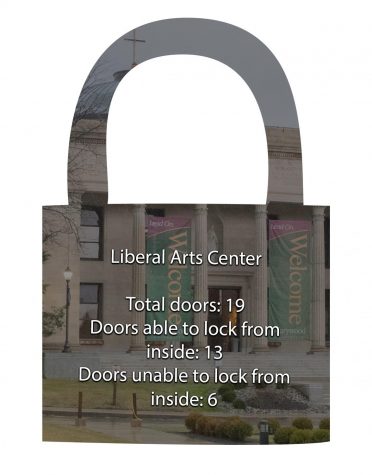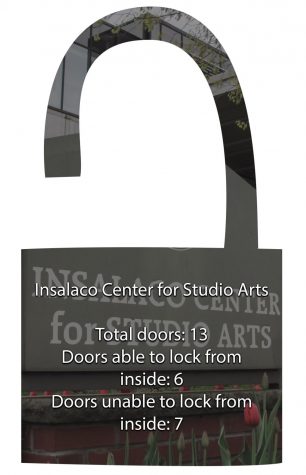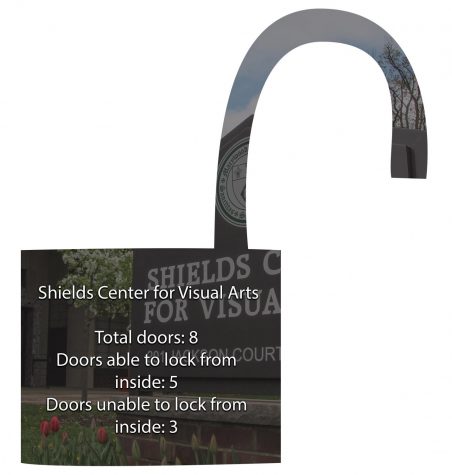Investigation after active shooter drill shows many classroom doors can’t be locked from inside
May 19, 2018
A Wood Word investigation found that out of 100 classroom doors investigated, only 39 could be locked from the inside.
With active shooter situations frequently taking place on campuses across the United States, students and professors are looking for the best ways to protect themselves in case of an emergency situation.
Marywood held its first active shooter drill of 2018 at the end of April to educate the Marywood community on what to do if there is an active shooter on campus.
The drill took place in the Liberal Arts Center (LAC) with an actor portraying the gunman and firing blank rounds in the Rotunda and throughout the building. During the drill, professors and students who were in LAC classrooms locked classroom doors to secure the room from the gunman.
The actor who was playing the shooter approached each closed door and rattled the handle to attempt to gain entry into the rooms. All of the classroom doors he checked were locked.
However, a Wood Word reporter sat in room 124 in a wing of the LAC where there were no other classes held to get a first-hand experience of what it was like during the drill. When the reporter went to lock the door after hearing the first gunshot, she found the classroom she was in did not have a lock on the inside of the door.
Upon further investigation, The Wood Word discovered that not all classroom doors in the LAC have properly functioning, if any, locks on the doors that can be turned from the inside of the classroom. Additionally, other classrooms in different buildings do not have locks on the inside of the door that can be used to prevent someone from entering the room.
National groups recommend classroom doors should lock from inside
The National Association of State Fire Marshals suggests secondary schools should have doors that are lockable from inside the classroom to best protect teachers and students.
A report from the School Safety Infrastructure Council from Connecticut’s state government, which was in response to the 2012 Newtown Elementary School shooting, includes a standard requiring classrooms to lock from the inside.
In a final report from the Sandy Hook Advisory Commission from 2015, the commission found “there has never been an event in which an active shooter breached a locked classroom door.”
Specifically for colleges and universities, the 2013 Guide for Developing High-Quality Emergency Operations Plans for Institutions of Higher Education, which is a compilation of work from the U.S. Department of Education and other federal agencies, recommends students select a shelter-in-place location during an active shooter situation that has thick walls, solid doors with locks, minimal interior windows and duress alarms.
The Wood Word investigates locks on Marywood classroom doors
The Wood Word investigated classroom doors across campus to see which doors could be locked from the inside in case of an active shooter situation.
In the LAC, 13 classroom doors out of a total 19 are lockable from the inside. Three classrooms on the first floor were missing locks and unable to be locked from the inside. Also on the first floor, two classroom doors had locks that were not functioning properly with bolts that did not keep the door locked. One of the classrooms did not lock from the inside on the second floor of the LAC.

In the Center for Natural and Health Sciences, none of the classroom doors could be locked from the inside. Lab doors all locked from the outside and required a punch code or a card swipe to enter the room.
Classrooms on the terrace level of the Learning Commons all required a card swipe to enter, making them locked from the outside, but with no way to lock from the inside of the room. Two classrooms on the second floor and one classroom on the third floor could not be locked from the inside.
Additionally, no classrooms on the first floor and in the basement of the Sette LaVerghetta Center for the Performing Arts could be locked from the inside.
In the Insalaco Center for Studio Arts, seven of 13 doors checked could not be locked from the inside. However, six of those doors, which were mainly to studios and shop rooms, were locked from the outside and propped open with a door wedge at the time of The Wood Word’s investigation. This would make it possible for students to lock the door from the inside of the room by removing the door wedge in an emergency situation.

In the Shields Center for Visual Arts, three of eight classrooms in the building could not be locked from the inside. The other five classrooms could be locked from the inside.

None of the classrooms in both the O’Neill Center for Healthy Families and the McGowan Center for Professional studies could be locked from the inside.
Out of the two classrooms in the gym on the second floor, one could not be locked from the inside.
In sum, fewer than 40 percent of classrooms on Marywood’s campus can be locked from the inside in the case of an active shooter situation.
The Wood Word chose not to publish specific classroom numbers that do not lock from the inside as a safety precaution.
PA State Police Department makes suggestions for active shooter situations
Community Services Officer Trooper Mark Keyes from the Pennsylvania State Police Department, who also instructs active shooter training sessions, said the decision to lock classroom doors from the inside is left to each individual school. He said there are positives and negatives to doors locking from the inside. However, in an active shooter situation, he said it is better to have doors that can’t be breached.
Keyes advised professors to have a game plan in place if they are in a classroom that does not lock on the inside.
“In almost all reported cases, shooters are on the move. They don’t want to take time to get things out of the way to get to people if they can’t easily get in the room,” he said. “They’re probably going to go down the hall to the next room looking for easy targets.”
He said having strong doors is helpful in these emergency situations compared to wooden doors with simple locks that a good-sized student could kick their way through. Keyes added that it is up to a university to see if they could financially make doorways stronger.
Marywood administrators respond to locks on inside of doors
Chief of Campus Safety Mike Pasqualicchio said the university is looking at finding solutions to the doors that do not lock.
“I would like to see every door lock on the inside as a safety measure for instances like [an active shooter drill],” he said.
Assistant Vice President of Buildings and Grounds Wendy Yankelitis said having locks on the inside of classroom doors depends on each classroom’s situation. She explained that some doors could be fit for a deadbolt, but the university needs to make sure the doors meet other building codes like the Americans with Disabilities Act.
“The reality of today’s world is you’re going to come into a situation whether it’s here or someplace else, [where] there’s an active shooter and you are going to be asked to address the situation with no lock on the door anyway,” Yankelitis said.
She added that campus safety is surveying classrooms to prioritize which buildings would benefit the most when taking funds from the buildings and grounds department’s operational budget to add locks.
Pasqualicchio emphasized that if students or professors find themselves in a classroom that does not lock from the inside, they should use different techniques to secure a door. He specifically mentioned using a door wedge to keep a door closed, blocking or barricading the door and using a belt to tie around the handle.
Yankelitis added that it is important to be educated on the creative ways to lock a door. She strongly encouraged all students to watch the video Pasqualicchio sent to the Marywood community in emails regarding the active shooter drill and to take active shooter drills seriously.
“I’d love to see locks on every single door, that would be the goal, but my bigger goal is so that students educate themselves to say, ‘I know how to respond to a lock on my door, no lock on my door, a barricade, I know how to do all those [things],’” she said.
According to Pasqualicchio, campus safety is looking into requiring Marywood IDs to access buildings around campus, such as the 24-hour swipe access that is now required to enter the O’Neill Center for Healthy Families. However, he said he doesn’t want the campus to have a “lockdown” feel if guests are trying to enter buildings.
“I’m curious to see the feedback from the students who use that building,” he said. “The big issue is getting students to carry their IDs on them. We run into that issue where students may be locked out.”
Yankelitis said there are plans to possibly implement card swipes on the outside of buildings around the LAC and Immaculata Hall areas, but the department still needs to figure out the logistics.
“We’ve had conversations in the past and continue to have conversations but there’s a good amount of planning that needs to go into [card swipes] before you actually put them in place,” she said.
For classrooms that are only accessible with card swipes or punch codes, Yankelitis said these safety measures are intended to protect after-hours students and secure the equipment in the rooms. She said she doesn’t think it’s necessary to add locks inside the classroom doors with card swipes.
Pasqualicchio said he thinks in addition to classrooms being safe, Marywood’s campus as a whole is safe.
“We strive to make [the classrooms] as safe as possible. I think they are safe.” Pasqualicchio said.
Yankelitis said she encourages students to call the maintenance department, put in a work order or report a situation if they notice something broken in their surroundings.
“I think that the training we’re doing and continuing to do will make us the safest we can be and a lot of it is on that individual person to go to those training sessions,” she said.
Briana Ryan and John Ferraro contributed to this report.
Contact the writer: [email protected]
Twitter: @RLookerTWW





